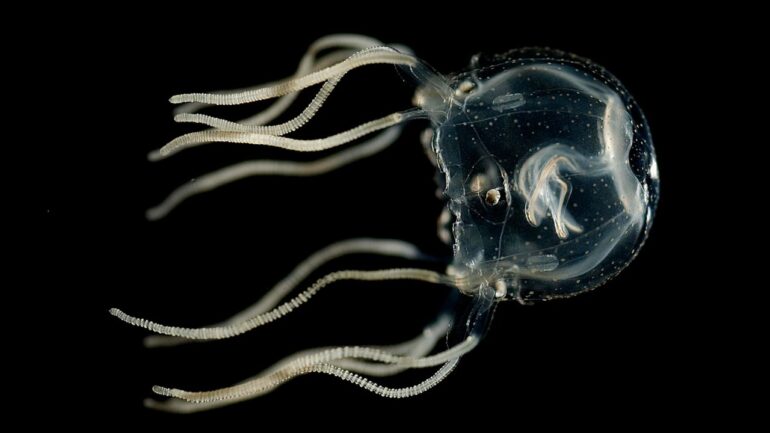TL;DR:
- Caribbean box jellyfish exhibit associative learning without a central brain.
- This challenges conventional notions about learning and cognition.
- Jellyfish offer a unique model for distributed learning systems in AI.
- Insights from jellyfish neural networks can enhance autonomous underwater robots.
- Non-biological learning systems may benefit from understanding jellyfish learning mechanisms.
- Implications extend into artificial intelligence and machine learning.
Main AI News:
In a stunning revelation, researchers have unveiled the remarkable learning abilities of the Caribbean box jellyfish, a creature devoid of a central brain. This newfound cognitive prowess challenges conventional wisdom, as these jellyfish exhibit associative learning, a trait previously associated with centralized nervous systems. Surprisingly, the jellyfish can associate physical encounters with visual cues, a feat that has far-reaching implications for the realm of artificial intelligence (AI) and machine learning.
Despite being among the most primitive life forms, jellyfish, belonging to the ancient Cnidaria phylum, lack a conventional centralized brain. Instead, they rely on a diffuse network of neurons, referred to as a nerve net, which is distributed throughout their gelatinous bodies. Yet, despite this apparent simplicity, these enigmatic creatures display a repertoire of complex behaviors, including feeding, mating, and obstacle avoidance. Notably, the Caribbean box jellyfish, measuring a mere centimeter in length, has astounded scientists with its capacity for associative learning.
This revelation challenges conventional wisdom surrounding cognitive processes and the presumed indispensability of a centralized brain for learning. The box jellyfish, and possibly other cnidarians like sea anemones, possess the ability for associative learning, a phenomenon heretofore thought to hinge on a centralized nervous system. This discovery offers a fresh perspective on the evolution of learning and cognition, suggesting that these capabilities may have emerged much earlier in the evolutionary timeline than previously believed.
Unraveling the intricacies of learning in such a rudimentary organism as the jellyfish carries profound implications for the fields of artificial intelligence (AI) and neural network research. The jellyfish’s decentralized nervous system, featuring autonomous “eye-brain” complexes known as rhopalia, serves as a novel model for distributed learning systems.
The study of moon jellyfish neural networks has already yielded valuable insights into movement regulation and the resilience of the nervous system, even in the face of impairments. Researchers at the University of Bonn have crafted a mathematical model to delve into how nerve cell excitation underpins the jellyfish’s agile movements. This research may pave the way for enhancing the autonomous control of underwater robots inspired by the principles of jellyfish locomotion, potentially revolutionizing the field of robotics.
The investigation into box jellyfish learning mechanisms may also exert a transformative influence on the development of non-biological learning systems. By deciphering how a seemingly unsophisticated organism like the jellyfish learns and adapts its behavior, we could envision AI systems that emulate this ability, learning from their surroundings and adapting in kind. This breakthrough could usher in a new era of resilient and adaptable AI systems capable of navigating complex and unpredictable environments.
Conclusion:
The discovery of associative learning in jellyfish, devoid of a central brain, heralds a paradigm shift in our understanding of cognition. This breakthrough could revolutionize the development of AI systems, particularly in distributed learning models and autonomous robotics, ultimately expanding possibilities in the market for resilient and adaptable technology solutions.

